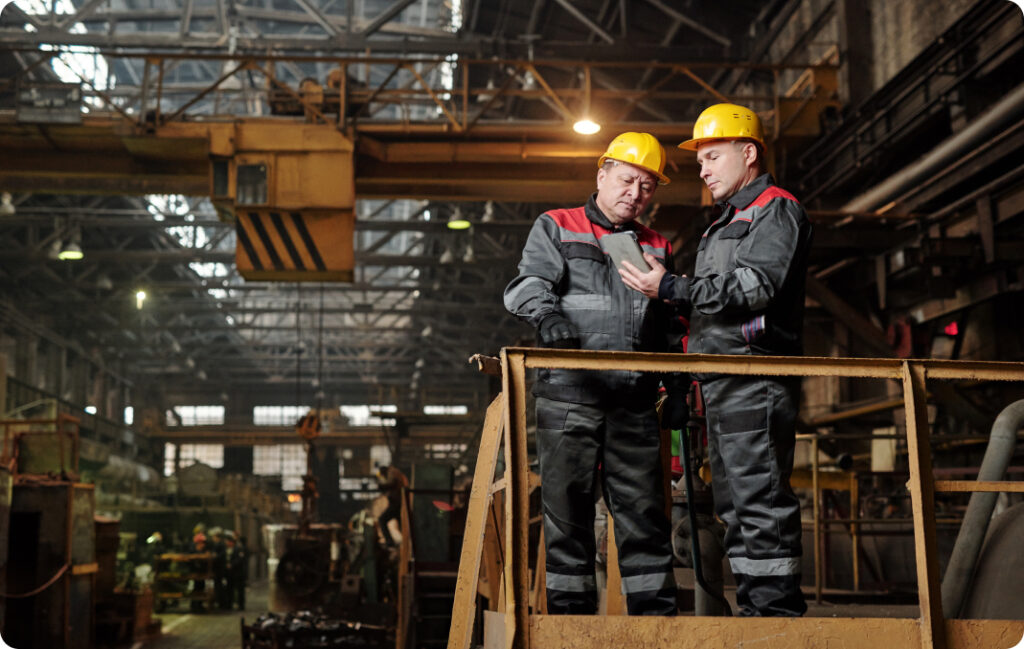Industrial safety is present in all areas of a company, but it is especially important when you have a production plant. This is because such facilities involve many risks.
In this article, we will discuss what industrial safety is and its importance. We will also cover the aspects you need to consider for its implementation, as well as the key factors to optimize it and keep people and facilities protected.
What is currently understood by industrial safety?
Industrial safety encompasses a set of regulations aimed at reducing hazards in the company and preventing, controlling, or mitigating their consequences. As the name suggests, it is applied in industrial environments such as plants or factories.
It also refers to the department within companies that systematically addresses the prevention of injuries or workplace accidents. It is especially applicable in industrial spaces.
Its greatest utility lies in mitigating risks by anticipating the occurrence of harm to people or facilities. In this way, it acts more as a preventive rather than reactive measure. It also covers the management and investigation of accidents and incidents, should they occur.
The most current perspective of the field is guided by standards such as ISO 45001 and ISO 14001. The former addresses Occupational Health and Safety, while the latter focuses on the environment.
In this regard, safety in industrial facilities aims to preserve life and health. In addition to considering factors such as order and cleanliness, it also addresses psychosocial elements, striving for the overall well-being of employees.
Objectives of Industrial Safety
The primary objective of this discipline is to achieve a Zero Accidents indicator in the plant. To accomplish this, detailed planning is carried out to identify hazards in the facilities and processes.
Based on careful planning, monitoring, execution, and control actions are determined to reduce the risk of accidents. The focus is always placed on the safety of people and the environment.
In this context, it is essential to inform employees about the risks and the actions needed to mitigate them. The goal of Zero Accidents can only be achieved with the participation of everyone.
Therefore, it is important to remember that industrial safety is the responsibility of everyone, not just the designated team. This makes it easier to comply with safety regulations, maintain order and cleanliness, conduct preventive maintenance, and use safety equipment, among other tasks.
Additionally, you must consider that the more complex your industry’s operation, the greater the risks. Therefore, you need support tools for monitoring, reporting, and following up on safety tasks.
Thus, it is essential to have a digital platform that allows recording findings in the workplace, so everyone can follow up on safety assignments.

Why is industrial safety important in the plant?
Production activities in an industrial plant are characterized by generating mass employment. Although rapid technological advancement has reduced the workforce in some cases, plants and factories generally maintain a high number of employees.
When significant groups of people gather in one place to carry out production tasks, organizations become responsible for the safety of their employees.
An appropriate system to control worker safety within the plant is key to ensuring productivity results for the company.
There are four key findings in Industrial Safety programs:
- Workplace accidents: These are sudden events that occur due to work-related causes and result in organic injury, functional impairment, disability, or death for the worker. They also include severe damage to the facility or the environment.
- Incidents: These are undesired events that, under slightly different conditions, could have caused injury to people, damage to the facility, or losses in the process.
- Unsafe act: Also known as a substandard act, it refers to any action taken by a worker in an unsafe or improper manner, increasing the likelihood of a workplace accident.
- Unsafe condition: This refers to a medium or situation present in the workplace, characterized by uncontrolled risks that may lead to workplace accidents.
5 Aspects You Must Consider to Ensure Industrial Safety
Below are five key points that you need to clearly establish to achieve the effectiveness of your safety system for workers in the plant:
#1 The Company’s Budget
The company must allocate a budget for the safety of its employees. The goal is not only to comply with government regulations or customer requirements; it is important to establish internal policies to ensure employee safety.
You can justify the budgets for Industrial Safety by delving into what it is and how it specifically benefits your company and processes. You can also present statistics on accidents and incidents that have occurred and the additional costs they have caused.
#2 The Plant and Its Conditions
If you have the opportunity to adjust the plant and its processes from the design stage, many future additional costs can be avoided. Following current regulations for the type of industrial plant when building and installing equipment is the best prevention strategy.
It is important to consider the plant’s location, ensuring it has access to water supply, electricity, communications, and transportation services. Additionally, you need to verify security conditions, authorized access, surveillance, monitoring, and communication with the police and fire department.
The materials used, calculations and designs, internal installations (electrical, hydraulic, etc.) should always comply with updated regulations and manufacturers’ specifications.
Regarding machinery and equipment, there are basic standards in plant layout to ensure a good process flow. Avoiding bottlenecks or loops in the process prevents risky situations.
Consider the following: access, lighting, secure anchoring, operational and safety area signage, emergency stops, guards or isolation of hazardous parts, and other safety recommendations provided by the manufacturer.
#3 Personal Protective Equipment
Personal Protective Equipment (PPE) is an aspect of Industrial Safety that has not been exempt from progress and innovation.
Today, there is equipment available for head, face, eye, ear, respiratory system, hand, foot protection, as well as for working at heights and in confined spaces. These items should be selected according to the occupation and specific risks.
It is necessary to establish control procedures for Personal Protective Equipment, from its acquisition, receipt from the supplier, storage, distribution, and usage.
#4 Continuous Worker Training
Industrial Safety requires the formation of an organizational culture. For this reason, ongoing, appropriate training with effectiveness verification is vital for developing a safety culture within the plant.
In industrial plants where the number of workers is high, training programs require control and follow-up to ensure that everyone receives the established training.
Raising awareness about the importance of workplace safety, self-care, and the value of the individual at home and in society makes people more receptive to the objectives of industrial safety.
#5 Site Monitoring
After designing and establishing the system, the next step is action: control. It is essential to monitor and verify daily compliance against indicators.
This verification allows you to see the achievements and opportunities for improvement so that you can make necessary adjustments. Organizations delegate these tasks to professionals responsible for the program and leading the system.
Technology is an indispensable tool and our great ally because handling a large amount of data, locations, environments, machines, equipment, people, roles, etc., becomes inefficient if only manual tools are used.
Source: PRYSMEX
